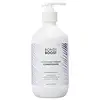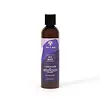What's inside
What's inside
 Key Ingredients
Key Ingredients

 Benefits
Benefits

 Concerns
Concerns

 Ingredients Side-by-side
Ingredients Side-by-side

Aloe Barbadensis Leaf Juice
Skin ConditioningBehentrimonium Chloride
PreservativeCetearyl Alcohol
EmollientGlycerin
HumectantCoco-Caprylate
EmollientPropanediol
SolventCaprylic/Capric Triglyceride
MaskingArgania Spinosa Kernel Oil
EmollientSimmondsia Chinensis Seed Oil
EmollientHydrolyzed Jojoba Esters
Skin ConditioningPanthenol
Skin ConditioningNiacinamide
SmoothingSodium Hyaluronate
HumectantCeramide Ng
Skin ConditioningRicinus Communis Seed Oil
MaskingVitis Vinifera Seed Oil
EmollientMacadamia Integrifolia Seed Oil
Skin ConditioningRosmarinus Officinalis Leaf Extract
AntimicrobialHydrolyzed Quinoa
Skin ConditioningHydrolyzed Adansonia Digitata Seed Extract
Biotin
AntiseborrhoeicParfum
MaskingPolyquaternium-7
Polyquaternium-10
Pentylene Glycol
Skin ConditioningCaprylyl Glycol
EmollientEthylhexylglycerin
Skin ConditioningCitric Acid
BufferingAloe Barbadensis Leaf Juice, Behentrimonium Chloride, Cetearyl Alcohol, Glycerin, Coco-Caprylate, Propanediol, Caprylic/Capric Triglyceride, Argania Spinosa Kernel Oil, Simmondsia Chinensis Seed Oil, Hydrolyzed Jojoba Esters, Panthenol, Niacinamide, Sodium Hyaluronate, Ceramide Ng, Ricinus Communis Seed Oil, Vitis Vinifera Seed Oil, Macadamia Integrifolia Seed Oil, Rosmarinus Officinalis Leaf Extract, Hydrolyzed Quinoa, Hydrolyzed Adansonia Digitata Seed Extract, Biotin, Parfum, Polyquaternium-7, Polyquaternium-10, Pentylene Glycol, Caprylyl Glycol, Ethylhexylglycerin, Citric Acid
Water
Skin ConditioningGlycerin
HumectantBetaine
HumectantCetearyl Alcohol
EmollientCetyl Alcohol
EmollientLinum Usitatissimum Seed Extract
PerfumingBrassicamidopropyl Dimethylamine
Skin ConditioningPolyglyceryl-3 Betainate Acetate
Oryza Sativa Extract
AbsorbentBiotin
AntiseborrhoeicCeramide NP
Skin ConditioningPhytosterols
Skin ConditioningInositol
HumectantCopper Tripeptide-1
Skin ConditioningSerenoa Serrulata Fruit Extract
Skin ConditioningCocos Nucifera Oil
MaskingCetyl Esters
EmollientC12-15 Alkyl Lactate
EmollientLactic Acid
BufferingLauramidopropyl Hydroxysultaine
CleansingCaprylhydroxamic Acid
Sodium Chloride
MaskingCaprylyl Glycol
EmollientPotassium Sorbate
PreservativeSodium Benzoate
MaskingWater, Glycerin, Betaine, Cetearyl Alcohol, Cetyl Alcohol, Linum Usitatissimum Seed Extract, Brassicamidopropyl Dimethylamine, Polyglyceryl-3 Betainate Acetate, Oryza Sativa Extract, Biotin, Ceramide NP, Phytosterols, Inositol, Copper Tripeptide-1, Serenoa Serrulata Fruit Extract, Cocos Nucifera Oil, Cetyl Esters, C12-15 Alkyl Lactate, Lactic Acid, Lauramidopropyl Hydroxysultaine, Caprylhydroxamic Acid, Sodium Chloride, Caprylyl Glycol, Potassium Sorbate, Sodium Benzoate
Ingredients Explained
These ingredients are found in both products.
Ingredients higher up in an ingredient list are typically present in a larger amount.
Biotin is a B vitamin that is naturally produced by our bodies. It is also called Vitamin H.
Our bodies use biotin in the metabolism process. It also helps our bodies use enzymes and move nutrients around. A biotin deficiency can lead to brittle hair and nails.
More research is needed on applying biotin topically. However, taking biotin orally has been shown to help nourish the skin, hair, and nails. They play a role in forming skin-hydrating fatty acids.
Biotin is water-soluble. It can be found in foods such as fish, eggs, dairy, nuts, and meat. Vitamin H stands for "haar" and "haut". These are the German words for hair and skin.
Learn more about BiotinCaprylyl Glycol is a humectant and emollient, meaning it attracts and preserves moisture.
It is a common ingredient in many products, especially those designed to hydrate skin. The primary benefits are retaining moisture, skin softening, and promoting a healthy skin barrier.
Though Caprylyl Glycol is an alcohol derived from fatty acids, it is not the kind that can dry out skin.
This ingredient is also used as a preservative to extend the life of products. It has slight antimicrobial properties.
Learn more about Caprylyl GlycolCetearyl alcohol is a mixture of two fatty alcohols: cetyl alcohol and stearyl alcohol. It is mainly used as an emulsifier. Emulsifiers help prevent the separation of oils and products. Due to its composition, it can also be used to thicken a product or help create foam.
Cetearyl alcohol is an emollient. Emollients help soothe and hydrate the skin by trapping moisture.
Studies show Cetearyl alcohol is non-toxic and non-irritating. The FDA allows products labeled "alcohol-free" to have fatty alcohols.
This ingredient is usually derived from plant oils such as palm, vegetable, or coconut oils. There is debate on whether this ingredient will cause acne.
Due to the fatty acid base, this ingredient may not be Malassezia folliculitis safe.
Learn more about Cetearyl AlcoholGlycerin is already naturally found in your skin. It helps moisturize and protect your skin.
A study from 2016 found glycerin to be more effective as a humectant than AHAs and hyaluronic acid.
As a humectant, it helps the skin stay hydrated by pulling moisture to your skin. The low molecular weight of glycerin allows it to pull moisture into the deeper layers of your skin.
Hydrated skin improves your skin barrier; Your skin barrier helps protect against irritants and bacteria.
Glycerin has also been found to have antimicrobial and antiviral properties. Due to these properties, glycerin is often used in wound and burn treatments.
In cosmetics, glycerin is usually derived from plants such as soybean or palm. However, it can also be sourced from animals, such as tallow or animal fat.
This ingredient is organic, colorless, odorless, and non-toxic.
Glycerin is the name for this ingredient in American English. British English uses Glycerol/Glycerine.
Learn more about Glycerin